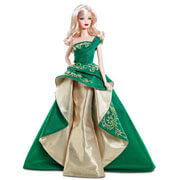Virtually any time I go to a gathering and people find out what I do, I get the same question. “I have an old [fill in toy name here]. What is it worth?” Really, it never fails. While I know a lot about toy history, our focus here at Time to Play is on new toys, not putting a value on old toys.
Mostly, I have to disappoint people, though, and let them know that there are only a handful of super rare toys, which, in mint condition, would help defray the cost of college tuition. Those Holiday Barbies that you’ve been storing in the attic, or those much loved and played with Teenage Mutant Ninja Turtles from your childhood probably aren’t going to fetch a lot of money. Yes, we all hear the stories about a big score at a yard sale, or the find in an antique shop. The reality, though, is that when it comes to toys, you should collect things you love. The pleasure of owning something that’s a touchstone to your childhood and makes you smile when you look at it has a value that can’t be measured in cold, hard cash.
But we can dream, can’t we? Well, that’s the premise behind a brand new show on the Travel Channel called Toy Hunter. I sat down with the host Jordan Hembrough and talked about toy collecting.
Jordan’s an amazing guy who specializes in buying and selling old toys. He agrees that you should “collect what you love and love what you collect.” And, he says, that in his travels, he found some wonderful surprises, and broke a few hearts when something a person loved had more sentimental than cash value.
Another reason that rare toys have so much value is that most of the originals were actually played with, which is why a) they create so many wonderful memories that people want to collect them and b) finding one is so difficult.
Oh, and about those toys that have been so aggressively marketed as collectibles in recent years? Forget about their appreciating in value. The companies made so many and the potential for so many to be put away and saved means that they aren’t going to get much more valuable—at least not in our lifetimes. And one of the number one rules of toy collecting—or any antique collecting—is that something only has the value that a person is willing to pay for it in the moment.
All of this brings me back to one of my favorite themes: toys are to be played with. We want our kids to fire up their imaginations and experience the creative freedom of play. Through our play we begin to become ourselves, and it’s the memories of those times that give value to old toys in later years—not the pieces of plastic. When we see former selves in a toy that was meaningful to us as kids and we project our memories onto those toys, that’s when they acquire value in the present.
Hembrough agrees, as you can see in our interview. But that doesn’t mean that the chase of the elusive toy can’t be exciting, as you’ll see in the show. Be sure to check it out Wednesday nights at 9 p.m. on The Travel Channel.

